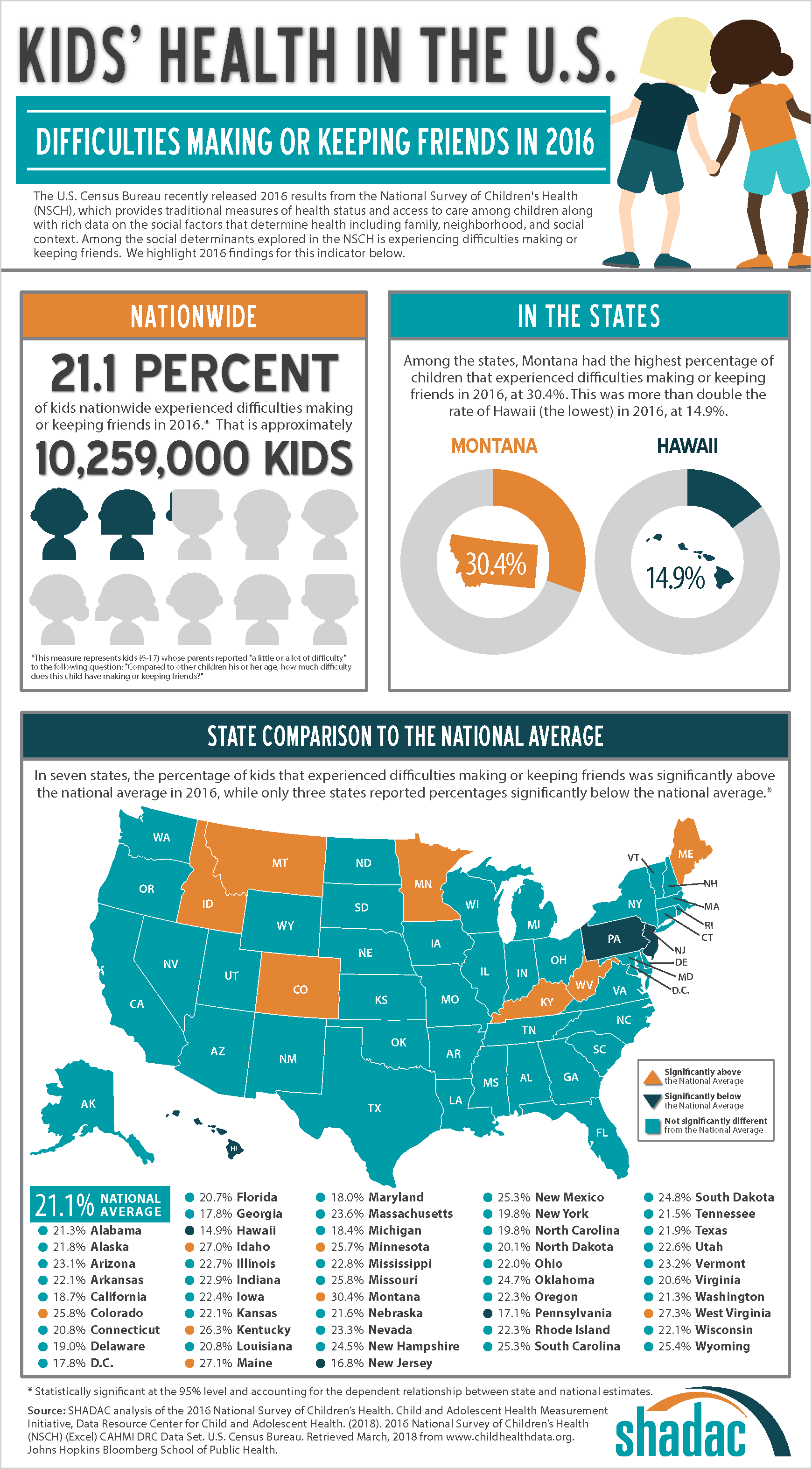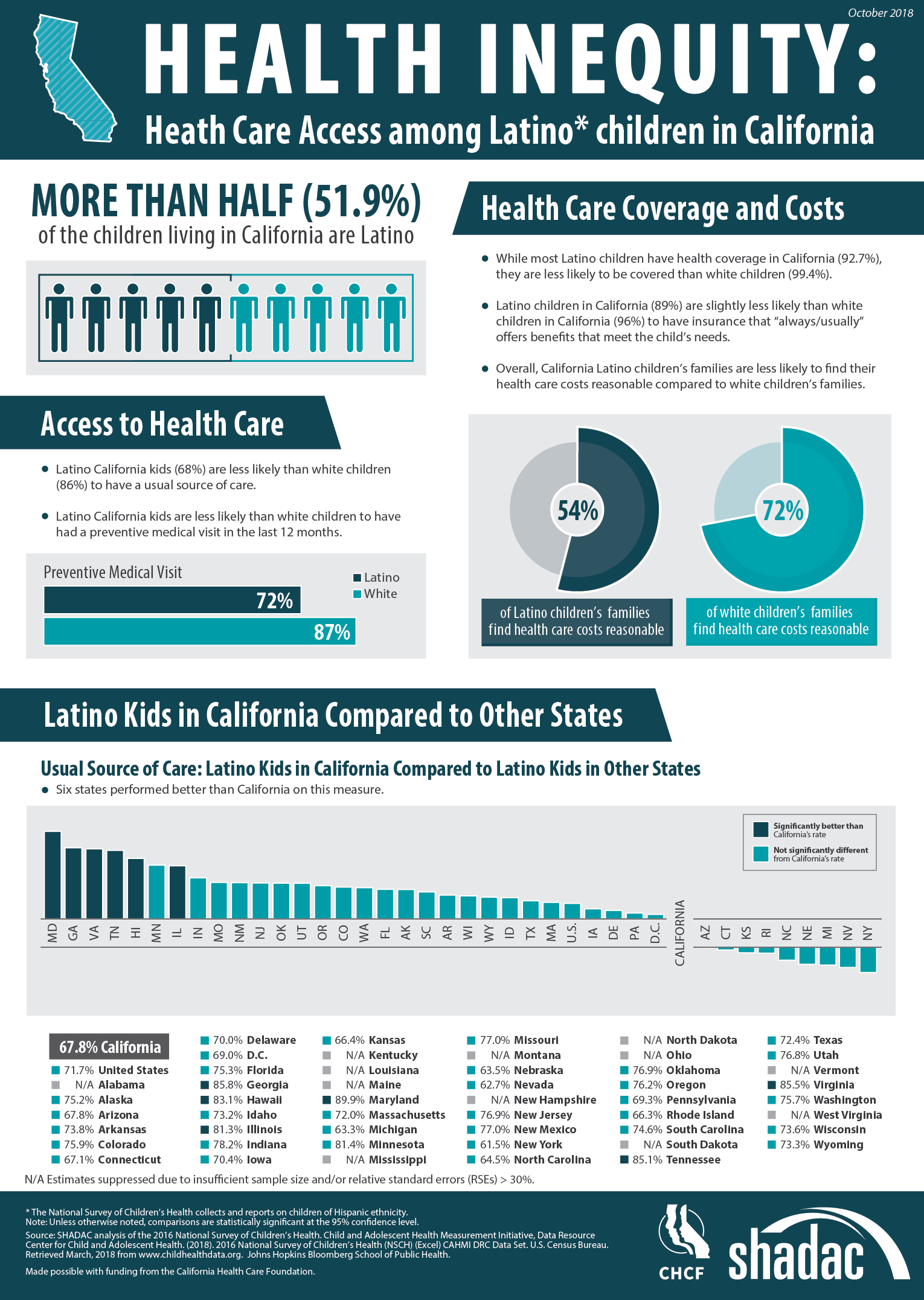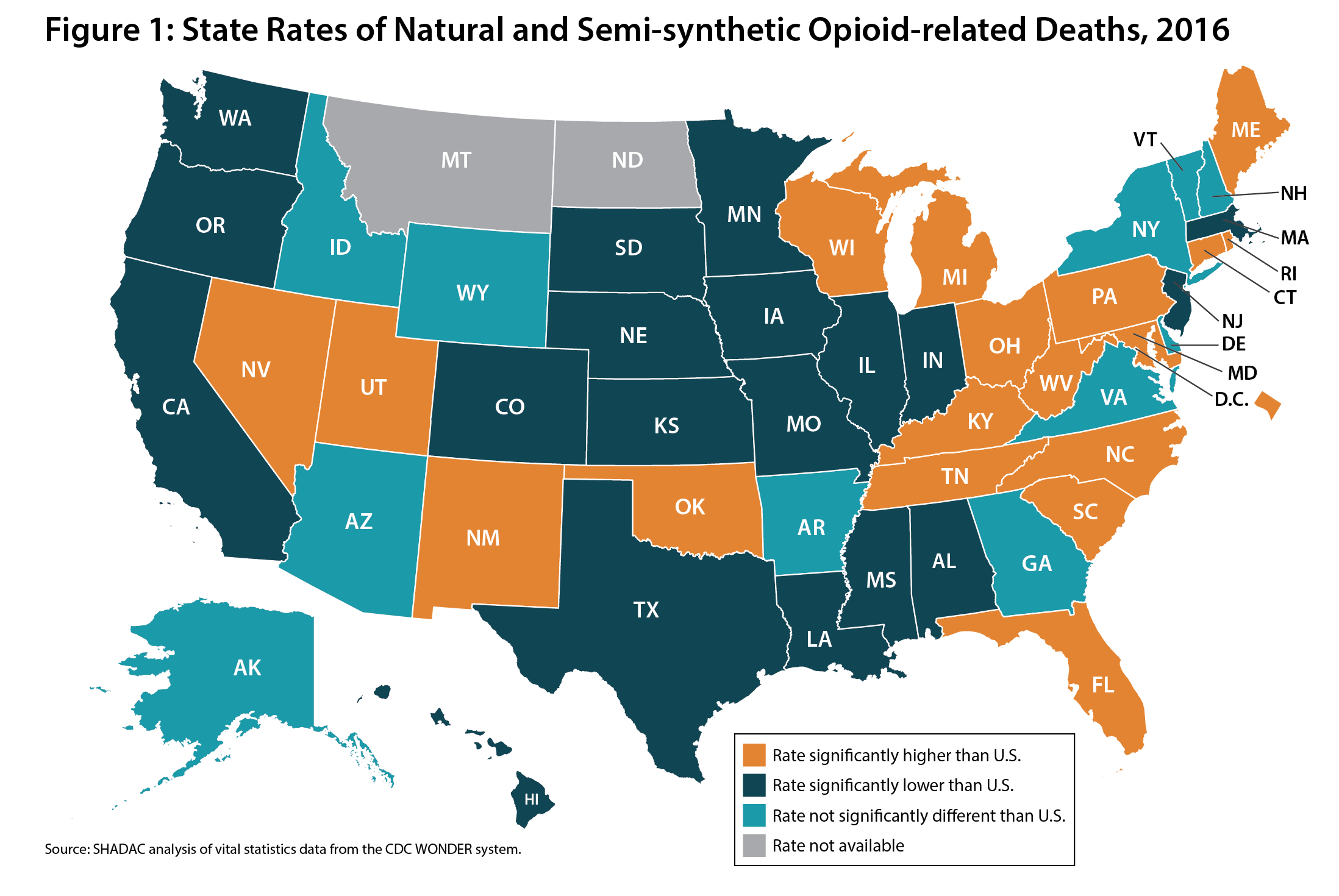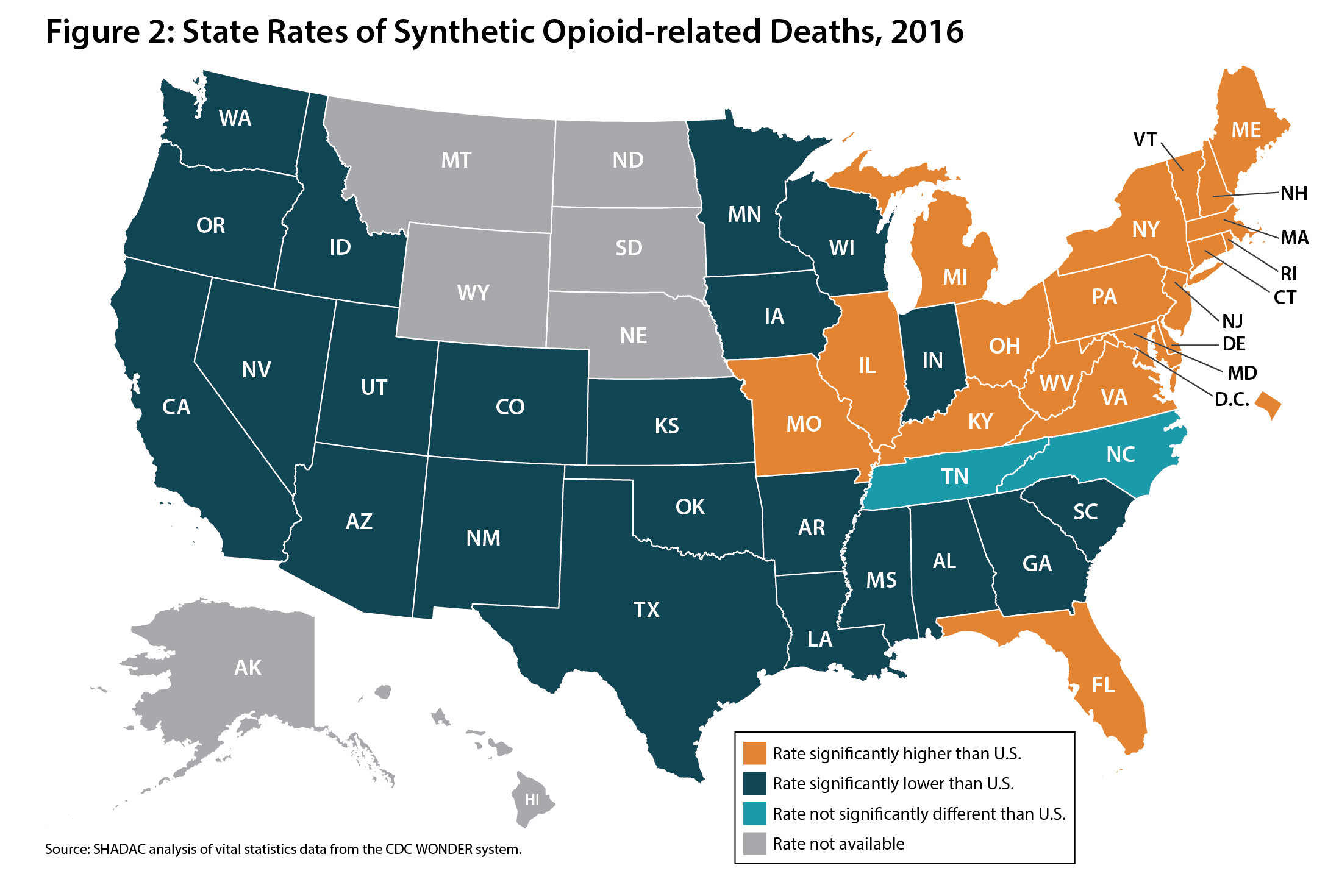Blog & News
Latino Children in California Face Inequitable Access to Care (Infographic)
October 31, 2018:According to the 2016 National Survey of Children’s Health (NSCH), Latino children in California face lower access to health care than their white counterparts across multiple access indicators.
Despite representing more than half of children living in the state, Latino children are less likely than white children to: have health insurance coverage, have insurance benefits that meet their needs, find their health care costs reasonable, have a usual source of care, and have had a preventive medical visit in the last twelve months. The infographic presented here illustrates the 2016 NSCH estimates for these measures for both Latino and white children and also compares California’s performance to other states on the percentage of Latino children who have a usual source of care.
About the Data
The National Survey of Children’s Health is an annual survey funded and directed by the Health Resources and Services Administration (HRSA) Maternal and Child Health Bureau (MCHB). Learn more about the NSCH at www.childhealthdata.org.
Publication
Comparing Federal Government Surveys That Count the Uninsured: 2018
This brief provides an annual update to comparisons of uninsurance estimates from four federal surveys1:
- The American Community Survey (ACS)
- The Current Population Survey (CPS)
- The Medical Expenditure Panel Survey - Household Component (MEPS-HC)
- The National Health Interview Survey (NHIS)
In this brief, we present current and historical national estimates of uininsurance along with the most recent available state-level estimates from these surveys. We also discuss the main reasons for variation in the estimates across the different surveys.
1 Another federal survey that provides estimates of the uninsured is the Behavioral Risk Factor Surveillance System (BRFSS), which provides uninsurance estimates for the adult population 18 years and over nationally and among states. Details about the BRFSS are included in Appendix A of the brief, and estimates from the BRFSS are provided in Appendix B.
Publication
Exploring the New State-Level Opioid Data on SHADAC's State Health Compare: Webinar
Date: September 5, 2018
Time: 12:00 p.m. - 1:00 p.m. Central
Watch a recording of the event below, or download a PDF of the presentation slides and the event transcript.
Between 2000 and 2016, the annual number of drug overdose deaths in the United States more than tripled, from 17,500 to 63,500, and most of these deaths involved opioids. Despite widespread increases in overdose death rates from natural and semi-synthetic opioids, synthetic opioids, and heroin, individual states’ death rates varied widely. For example, in 2016, Nebraska’s rate of 1.2 deaths per 100,000 people was the lowest in the U.S. for natural and semi-synthetic opioids, while West Virginia’s rate (the highest) was more than 15 times larger, at 18.5 deaths. These deaths are the most glaring indication of the growing crisis of opioid abuse and addiction that has been spreading unevenly throughout the country over the past two decades.
On this SHADAC webinar, Research Fellow Colin Planalp examined the United States opioid epidemic at the state level, analyzing trends in overdose deaths from heroin and other opioids, such as prescription painkillers. Using data available through SHADAC’s State Health Compare, he also looked at which states have the highest rates of opioid-related deaths and which have experienced the largest increases in death rates.
Mr. Planalp was joined by SHADAC Research Fellow Robert Hest, who discussed the data on opioid-related overdose deaths from the U.S. Centers from Disease Control and Prevention (CDC) that are available on SHADAC’s State Health Compare. He also spoke about State Health Compare data from the U.S. Drug Enforcement Administration (DEA) on sales of common prescription opioid painkillers, and demonstrated how to access and use the data for state-level analyses.
Event Resources
The Opioid Epidemic: National Trends in Opioid-Related Overdose Deaths from 2000 to 2016 (SHADAC Brief)
The Opioid Epidemic: State Trends in Opioid-Related Overdose Deaths from 2000 to 2016 (SHADAC Brief)
Significance Testing Using State Health Compare (SHADAC Brief)
Blog & News
Kids' Health Data Highlight: Difficulties Making or Keeping Friends in 2016 (Infographic)
August 16, 2018:It is increasingly clear that health is determined not just by biological and clinical factors but to a greater extent by socio-demographic factors. With this in mind, we need data for monitoring the social determinants of health just as we do for monitoring biological and clinical determinants. The U.S. Census Bureau recently released estimates from the 2016 National Survey of Children’s Health (NSCH), providing a data source that is ideal for precisely this purpose. The NSCH provides traditional measures of health status and access to care among children along with rich data on the social factors that determine health including family, neighborhood, school, and social context.
SHADAC is highlighting state-specific findings from the 2016 NCSH on measures that illustrate where states are closer to achieving a culture of health and where improvements can be made. As additional years of NCSH data are released, we will be able to monitor trends in these indicators to track progress in developing a culture of health over time.
 Difficulties Making or Keeping Friends
Difficulties Making or Keeping Friends
According to data from the NSCH, 21.1 percent of children nationwide (approximately 10,259,000 children) experienced difficulties making or keeping friends in 2016. This measure includes kids (ages 6-17) whose parents reported "a little or a lot of difficulty" to the following question: "Compared to other children his or her age, how much difficulty does this child have making or keeping friends?"
Among the states, the percentages of children that experienced difficulties making or keeping friends in 2016 were significantly above the national average of 21.1 percent in seven cases: Montana (30.4%), West Virginia (27.3%), Maine (27.1%), Idaho (27.0%), Kentucky (26.3%), Colorado (25.8%), and Minnesota (25.7%). Three states had percentages below the national average for this measure: Hawaii (14.9%), New Jersey (16.8%), and Pennsylvania (17.1%).[1]
Click on the infographic for additional state-level information about children living in neighborhoods with no amenities.
Additional Kids' Health Data Highlights
Kids' Health in the U.S.: Parental Attendance at Kids' Activities in 2016
Kids' Health in the U.S.: Living in Neighborhoods with No Amenities in 2016
Kids’ Health in the U.S.: Living in Supportive Neighborhoods in 2016
Kids’ Health in the U.S.: Living in Working Poor Households in 2016
Kids’ Health in the U.S.: Trouble Affording Nutritious Meals in 2016
More about the NSCH
The NSCH was administered three times prior to 2016 – in 2003, 2007, and 2011/12. However, the 2016 NSCH is different because it integrated the NSCH with the National Survey of Children with Special Health Care Needs (NS-CSHCN) and introduced a number of new survey items, establishing a new baseline. Going forward, the NSCH will be administered annually. The survey is administered online and via mail, and survey results are weighted to represent the population of non-institutionalized children ages 0-17 who live in housing units nationally and in each state.
The full 2016 NSCH public-use file (PUF) is available on the Census Bureau’s NSCH page.
[1] Statistically significant differences are calculated at the 95% level and account for the dependent relationship between state and national estimates.
Blog & News
The Changing Opioid Epidemic: State Trends, 2000-2016
August 9, 2018:In a recent blog post, we highlighted an issue brief examining the evolution of the opioid overdose crisis at the national level, finding dramatic increases in deaths from heroin and synthetic opioids within the past few years. This blog post focuses on a related issue brief on state trends in the opioid crisis.
Although opioid overdose deaths have measurably increased across the U.S., some states have been more severely affected by particularly high death rates. Additionally, as the national opioid crisis has evolved, some states have been especially hard-hit by the rise in deaths from heroin and synthetic opioids.
This blog post highlights a new SHADAC brief that uses vital statistics data from the CDC WONDER system to analyze differences in state opioid overdose deaths for different types of opioids (i.e., prescription painkillers, heroin, and synthetic opioids). This state-focused brief is a companion piece to a national brief that provides additional background on the problem of opioid overdoses.
Key Findings
Although national data on opioid overdose deaths show a shift in the past few years—from deaths related mainly to prescription painkillers earlier in the epidemic to mostly heroin and synthetic opioids in the past few years—state date illustrate a more-nuanced pattern.
Since 2000, most states have experienced statistically significant increases in death rates from prescription painkillers (Figure 1). And the states with relatively high rates of deaths from prescription painkillers represent geographically diverse areas of the country, including the 2016 highest rates in West Virginia, Utah, and Maine.
However, the shift in deaths to heroin and synthetic opioids has been more regionally concentrated in a contiguous block of states, primarily east of the Mississippi River and from Maine and Wisconsin in the north to Kentucky and Virginia in the south (Figure 2). The states with the highest 2016 rates of heroin deaths were the District of Columbia, West Virginia and Ohio. The states with the highest 2016 synthetic opioid death rates were New Hampshire, West Virginia, and Massachusetts.
Want to Learn More? Explore the Data at State Health Compare
SHADAC's State Health Compare tool includes the CDC Wonder data about opioid-related deaths used for this analysis. Click here to explore, visualize, and/or download the data.
Related Content: September 5th SHADAC Webinar Explored New State-Level Opioid Data on SHADAC's State Health Compare













